Introduction
- Books Name
- CBSE Class 6 Science Book
- Publication
- Param Publication
- Course
- CBSE Class 6
- Subject
- Science
Introduction
You see a large variety of things around you. Some of these - such as tables, chairs, clothes, rivers, oceans, sand, etc. are called non-living things. Plants and animals are living things. All these living and non-living things have different shapes and sizes. Living organisms have several characteristics which rnake them different from non-living things.
The Living Organisms Characteristics and Habitats
- Books Name
- CBSE Class 6 Science Book
- Publication
- Param Publication
- Course
- CBSE Class 6
- Subject
- Science
CHARACTERISTICS OF LIVING THINGS
• Definite Shape and Size
Each kind of living being possesses a characteristic form and size. For example, a dog always has a form different from a bird. Different breeds of dogs may vary slightly in height and other features but they all have a more or less similar form.
• Living Things are Made up of Cells
Just as a building is made up of stones or bricks, all living organisms are made up of cells. Non-living objects do not have cellular structure. Cells are too small to be seen without a microscope.
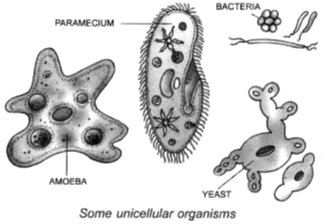
Some plants and animals consist of only a single cell and are called unicellular organisms. Some examples of unicellular organisms are: amoeba, paramecium, bacterium and yeast. There are other plants and animals whose body is made up of many cells. They are called multicellular organisms. Man, cat, pine, rose plant, etc. are such organisms.
• Living Things Move
Movement is one of the most important signs of life. Most animals move about freely from place to place. This is called locomotion. They move from place to place to find food, shelter and to escape from their enemies.Plants remain fixed to the soil at one place. They show movements of their parts. Roots always grow towards soil and shoot towards light. Opening and closing of stomata and flowers are other examples of plant movemens.
• Living Things are Sensitive
You show some immediate response to the situations you are facing. The dust particles, the hot object and the delicious dish are the stimuli. Closing and rubbing of eyes, withdrawing of hand, and water in the mouth are the responses.
All living organisms respond to stimuli because of sensitivity or irritability or responsiveness.
Plants also respond to stimuli. Many flowers open early in the morning and close during the day. Rat-ki-rani flowers open at night and close during the day. The leaves of the Mimosa the sensitive ‘Touch-me-not’ plant, fold and droop on touchin.
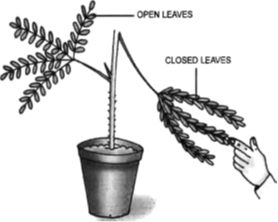
• Living Things Need food to Live
Different living organisms have different methods of getting food. All green plants can make their own food with carbon dioxide, water, chlorophyll and sunlight. The process is called photosynthesis.
Animals cannot make their own food. Th depend upon other living or dead organisms for their food. Goats, cows, buffaloes, sheep, rabbits and elephants eat only plants and are called herbivorous animals. Lions, wolves and leopards are called carnivorous animals because they feed on the flesh of other animals. Omnivorous animals like man, bear, etc. eat plants as well as animals.
• Living Things Respire
All living organisms respire. During respiration they take in oxygen and give out carbon dioxide. During respiration the food present in their body is broken down with the help of oxygen to release energy.
Plants also take in oxygen break down the food prepared during photosynthesis to release energy. They also give out carbon dioxide during respiration like animals.
• Living Things Excrete
All living organisms get rid of the waste and other harmful substances formed in their bodies. This process is called excretion. Human beings get rid of waste products from their bodies as urine, sweat, exhaled air, and as solid wastes in the form of faeces.
All animals have special organs for excretion. Kidneys, lungs, gills and sweat glands are the excretory organs of animals.
Plants throw out their gaseous waste products through small openings which are present in their leaves. These openings are called stomata. The other excretory products of plants are gums and resins.
Organisms and The Surroundings Where They Live
- Books Name
- CBSE Class 6 Science Book
- Publication
- Param Publication
- Course
- CBSE Class 6
- Subject
- Science
• Living Things Grow
All living things show growth. You are familiar with the growth of a baby into an adult. Plants also grow. Farmers plant seedlings in the field which in due course of time grow into matured plants. Growth in living thing is permanent and irreversible.
• Living Things Reproduce
All living organisms reproduce their own kind. Different animals show different mode of reproduction. Some animals produce their young ones through eggs, for example, hen, snake etc. Some animals like man, cow, sheep, goat, etc. give birth to young ones.
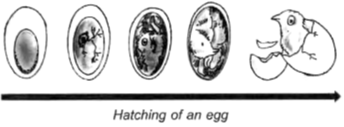
Plants also reproduce through seeds. Seeds are sown in the soil which on germination grow into new plants. Some plants can reproduce from their stems, roots, leaves or cuttings.
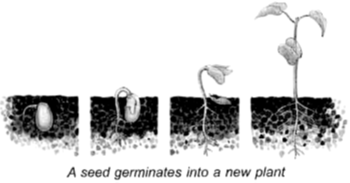
• Living Things Have a Definite Lifespan
Life Cycle : Living things follow a life cycle. They start their life form a single cell. In case of animals, the life cycle consists of birth, growth, reproduction and death .In plants, life cycle begins through seeds or spores. The life cycle of an organism may take a few hours, a few days or hundreds of years to complete.The period during which an organism completes its life cycle is called its life span. In case of bacteria, for example, the life span is very short.
• Lifespan of Some Organisms
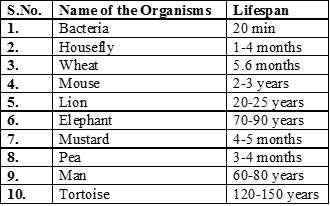
Do you know :
Father of Bilogy – the ancient Greek philosopher, Aristotle (384-322 B.C.) is known as the father of biology.
• Are there things in between living and non living : Yes, viruses are such entities existing in the universe. Viruses grow and multiply only when they are inside living things like man. Outside living bodies, they are lifeless and are just like a crystal.
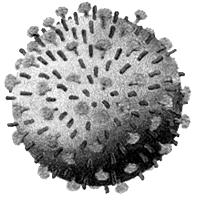
Habitat and adaption
- Books Name
- CBSE Class 6 Science Book
- Publication
- Param Publication
- Course
- CBSE Class 6
- Subject
- Science
Habitat And Adaptation
(a) Habitat :
The term habitat refers to the surroundings where organisms live.Every habitat is home for a certain living creature. Plants and animals have different features that help them to survive in their own habitat.
The components in a habitat are broadly classified into two types. they are biotic and abiotic.
Biotic components include all the livings organisms in a habitat. Abiotic components include all the non-living things in a habitat. These include air, rocks, water, sunlight and heat. All livings things depend on the abiotic components for all their needs. The abiotic components are very useful for the survival of the biotic components in a habitat. For example, sprouting is the first step where a new plant grows from a seed. The sprouting of a seed depends on abiotic components such as air, water, light and heat.
• The population of some species of turtles has declined due to the change in the earth’s temperature.
• Some popular theories believe that dinosaurs became extinct because of the changes in the earth’s temperature millions of years ago.
• Habitat can be terrestrial or aquatic :
• Terrestrial habitat : It refers to the land where all plants and animals survive. It includes mountains, deserts, forests and grasslands, as well as coastal and mountain regions. For example, camels and cactus plants live in deserts only.
• Aquatic habitat : It refers to the water where plants and animals survive. Aquatic habitat includes rivers, ponds, lakes, ocean and swamps.
(b) Adaptation :
Plants and animals develop certain features or certain habits that help them survive in their surroundings, and this is known as adaption. Different living creatures adapt to their habitats in different ways. For example, fish have gills that help them to live in water and use the oxygen dissolve in it. Plants that live in water have special tissues that help to take in dissoved gas from water. For example the ulva has ribbon-like leaves.
It takes thousands of years for a livings being to adapt to its habitat.
A journey through different habitats
- Books Name
- CBSE Class 6 Science Book
- Publication
- Param Publication
- Course
- CBSE Class 6
- Subject
- Science
• Adaptation in different habitats :
A. Terrestrial Habitats :
(i) Deserts : Desert is a water depleted area so basically plants and animals are adapted for little or less of water. Deserts are areas which receive very little rainfall. Sahara and Kalahari are two examples of deserts. Deserts are very hot and dry. Camels, cactus, date palm tree, rattle snake, are example of organisms found in deserts.
Adaptation In Desert Animals and Plants :
• Desert animals include camel, rats and snakes.
• To stay away from the intense heat during the day, rats and snakes stay in burrows deep in the sand. They come out only during the night, when it is cooler.
• Camel’s nostrils have long hairs to prevent the entry of sand and dust. They have no sweat glands in their skin.
• Adaptation in desert plants lose very less little water through transpiration.
• Desert plants either have no leaves or they have small or spine shaped leaves to reduce transpiration.
• Photosynthesis is usually carried out by stems.
• The stem is covered with a thick waxy layer which helps it to retain water.
• They have deep roots for absorbing water.
• Stomata are few, sunken in pits or covered with fine hairs.
(ii) Mountain regions : They are normally very cold and windy. In some places, snowfall may take place during winter.
• The leaves of some trees are needle - like so that snow and rain water can slide off easily.
• Animals have thick skin or fur to protect them from cold.
• Yaks have long hair to keep them warm.
• Snow leopard has thick fur on its body including feet and toes. This protects its feet from the cold when it walks on the snow.
• The mountain goat has strong hooves for running up the rocky slopes of the mountains.
(iii) Grasslands
• Lion lives in grassland.
• Its light brown colour helps it to hide in dry grasslands when it hunts for prey.
• The eyes in front of the face allow it to have a correct idea about the location of its prey.
• A deer has strong teeth for chewing hard plant stems.
• It has long ears to hear the movement of the predators.
• The eyes on the side of its head allow it look in all directions for danger.
• The speed of the deer helps them to run away from the predators.
B. Aquatic Habitats :
• Aquatic Adaptations
The animals which live in water are known as aquatic animals. Common aquatic animals -are fish, whale, crab, octopus, lobster, etc.
• They have the following adaptations:
1. They have streamlined body without a neck.
2. They have powerful tail and fins for swim.ming.
3. They have gills for respiration.
4. Some fishes have air bladder to make floating easier.
5. They have special body covering like cuticle, scales, shells and waxy coating which prevent rotting and decay.
Characteristics of organisms
- Books Name
- CBSE Class 6 Science Book
- Publication
- Param Publication
- Course
- CBSE Class 6
- Subject
- Science
Oceans :
• Sea animals like squid and octopus stay near the seabed and catch any prey that move towards them. When they move in water, they make their body shapes streamlined.
• Generally aquatic animals have gills to help them use the oxygen dissolved in water.
• Dolphins and whales do not have gills. They breathe in air through nostrils or blowholes that are located on the upper parts of their heads.This allows them to breathe in air when they swim near the surface of water.
• They can stay inside the water for a long time without breathing.
(ii) Ponds and Lakes
• Roots of plants are much reduced in size and their main function is to hold the plant in place.
• The stem is long, hollow and light.
• The stems grow upto the surface of water while the leaves and flowers float on the surface of water.
• Some plants are totally submerged in water, i.e, all parts of the plant grow under water. These plants have narrow and thin ribbon like leaves. Through highly divided leaves, the water can easily flow without damaging them.
• Amphibious Adptations In Animals
The animals which can live both on land as well as in water are called amphibious animals. Common amphibious animals are: frogs, toads and salamanders.
They have the following adaptations:
1. The skin is moist and slimy which help in respiration.
2. They can also respire through lungs.
3. The hind legs are long and strong which help in hopping movements on the land.
4. They have webbed feet for swimming.
C. Aerial or Volant Adaptations
Animals which are adapted for the aerial mode of life (flying) are known as volant animals. Common volant animals are an birds and bats.
They have the following adaptations:
1. They have streamlined body which is covered with feathers.
2. Their forelimbs are modified into wings.
3. The bones are light, hollow, spongy and contain many air cavities.
4. They have lungs for respiration.
5. The nervous system and sense organs are well developed.
6. The flight muscles are well-developed and their eyesight is very sharp.

 Param Publication
Param Publication
 PathSet Publications
PathSet Publications
